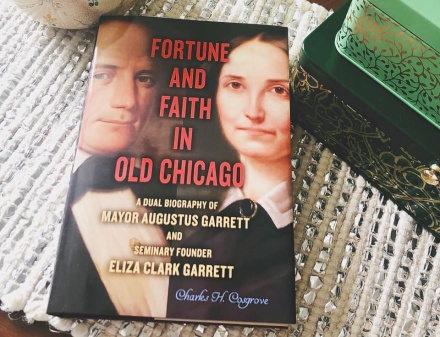New Book “Fortune and Faith in Old Chicago” Features Seminary Founder Eliza Clark Garrett
April 23, 2020

Published by Southern Illinois University Press in February 2020, Fortune and Faith in Old Chicago, was authored by Dr. Charles H. Cosgrove, who serves as professor of early Christian literature and the director of the PhD program at Garrett-Evangelical Theological Seminary. This engaging biography of Augustus Garrett and Eliza Clark Garrett tells two equally compelling stories: an ambitious man’s struggle to succeed and the remarkable spiritual journey of a woman attempting to overcome tragedy. By contextualizing the couple’s lives within the rich social, political, business, and religious milieu of Chicago’s early urbanization, Cosgrove fills a gap in the history of the city in the mid-nineteenth century.
To learn more about his new book we recently reached out to Cosgrove. What follows is a series of questions and answers providing further context for the book and keen insights into the Garretts.
As employees and students of Garrett-Evangelical, we pass by the portraits of Eliza and Augustus Garrett hanging in the lobby stairwell every single day, yet many of us know very little about them. So, who were Augustus and Eliza Garrett?
Augustus and Eliza Garrett were a married couple from New York State who traveled to various parts of the United States in the 1830s, finally winding up in Chicago in the very early years of the city. By then they had lost three young children and had gone deep into debt from Augustus’ entrepreneurial misadventures in Cincinnati, New Orleans, and Nachitoches. In Chicago, however, Augustus became a wealthy businessman and a popular politician, serving twice as the city’s mayor. After his premature death, Eliza devoted her portion of his large estate to found Garrett Biblical Institute.
Today, from her portrait in the stairwell, she looks across at him and says, with just a hint of apology, “You know you should have done ‘some good in the world’ with all your wealth like I have done with it.” And he looks back at her and says nothing. Is he annoyed, resigned, amused that his portrait ended up adorning the halls of a theological seminary, when he had done everything he could to prevent any of his estate from going to “worthy causes?”
Through your research, what did you learn that you didn’t know before about Eliza and/or Augustus? And, what surprised you the most?
Very soon after Eliza’s own death, the Methodists who celebrated Garrett Biblical Institute began to portray her in hallowed terms. She was in fact a kind-hearted, unassuming, charitable, dedicated laywoman all her life, first as a Presbyterian and later as a Methodist. What her admirers did not say or know was that throughout her life she also felt a lack in herself of the inner spiritual sentiment, the palpable religious experiences, that others described as reassuring signs of their own conversion and sanctification. As for Augustus, religious experience was no enduring concern of his, although he was very emotional and underwent two dramatic but short-lived conversions at revival meetings. His relationship with organized religion was otherwise rather rocky.
The founding of Garrett Biblical Institute in 1853 by Eliza Garrett was a bold and courageous undertaking. What events or insights into the Garretts do you think led to this historic moment?
Eliza founded a theological school, but her original intention was to establish a college for women, a very progressive idea at the time. But Methodist clergy and other churchmen she trusted told her that ministerial education was a more pressing need. She warmed to their vision but clung to her plan for a school of higher education for women. In the end, yielding more to their side than to her own inclinations, she devoted her estate to founding a theological school but with the provision that any surplus from the earnings of the estate not needed for the biblical institute would be used to establish a female college. There never was any unneeded surplus. But a happy outcome is that Garrett Biblical Institute was one of the very first theological schools (actually the second in history after Boston School of Theology) to grant a ministerial degree to a woman, doing so within just twenty-five years of the school’s opening.
Beyond the name of the seminary, how do you see the impact of Eliza Garrett and her decision to establish a biblical institute play out in the seminary today? If Eliza Garrett could speak to us today, what do you think she would say about Garrett-Evangelical Theological Seminary?
If Eliza could speak to us today, she might encourage us to keep the faith and serve others even when tragedy or doubt or despair weigh down our own spirits. She might also tell us to be open to progressive movements in our own time and to do what we can to make the world a better place. She did.
To learn more about Fortune and Faith in Old Chicago or to purchase your copy, visit the Southern Illinois University Press website. You can currently receive 20% off of the cover price when you add the e-book version for just $5. Add both formats to your cart and enter the code BUNDLE.
Charles H. Cosgrove is a professor of early Christian literature and the director of the PhD program at Garrett-Evangelical Theological Seminary, a union of schools descended from the institution founded by Eliza Garrett in 1853 and located on the campus of Northwestern University. He is the author of numerous books and articles in a wide range of fields, including theology, ethics, ancient music, and legal history. A lifelong native of the Chicago area, he is an aficionado of the city’s history and makes the occasional appearance in area music venues as a professional jazz trombonist.

